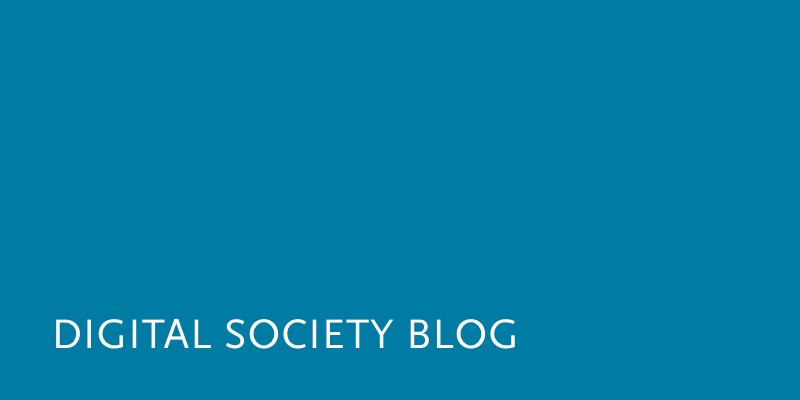Unsere vernetzte Welt verstehen

Wird Blockchain Ihr Geschäftsmodell auf den Kopf stellen?
Blockchain, die Technologie hinter Kyptowährungen wie Bitcoin, ist in aller Munde. Es wurde als „die Technologie, die das nächste Jahrzehnt der Wirtschaft verändern wird‟ und als „die bedeutendste technologische Entwicklung seit dem Internet‟ gepriesen. Dennoch ist die disruptive Kraft der Blockchain-Technologie bisher beschränkt, meint HIIG-Forscherin Jessica Schmeiss. Vielmehr bietete sie abseits des Hypes eher eine Möglichkeit für Unternehmen, ihre bestehenden Geschäftsprozesse kostengünstiger und effizienter zu gestalten.
Blockchain, the technology behind cryptocurrencies like Bitcoin, has received much attention in the past two years, praising it to be “the technology most likely to change the next decade of business” and “the most consequential development in information technology since the internet” (Werbach, 2016; Tapscott & Tapscott, 2016). The question arises, if blockchain technology will really pave the way for disruptive (digital) business models in the near future.
What is a blockchain?
While the technology itself is highly complex, the underlying idea is quite simple. A blockchain is a method of storing data digitally in a vast global database that is open to anyone and runs on a decentralised network of millions of devices. Trust in this network is established through transparency and mass collaboration, enabled by highly sophisticated encryption technology. Essentially, “blockchain technology allows parties who don’t fully trust each other to come to a consensus about the existence and evolution of a set of shared facts without having to rely on a trusted third party.” (adapted from Greenspan, 2016).
There are a number of key characteristics that make a blockchain such a unique technology and provide a basis for transactions between parties that do not trust each other.
- A blockchain enables disintermediation. Each party of the network has access to an encrypted copy of the database and its entire history and can thus record and verify specific events of value – a transaction, an agreement, a contract, ownership etc. No trusted third party is necessary to verify the transaction.
- A blockchain is transparent. All transactions are visible to all parties in the network. Anonymity is guaranteed through a unique alphanumeric address that is used for identification.
- All records are irreversible. A transaction that has been entered into the database cannot be altered because it is linked to every previous transaction. Highly sophisticated computational methods are used to ensure that all records on the database are permanent, chronologically ordered and available to everyone on the network.
- A blockchain in its original form is non-permissioned (or public). Everyone who wishes to participate in a blockchain will be granted access. Hence, no central party decides about permissions. Additionally, permissioned (or private) blockchains have emerged that only allow an authorised set of users to join, read, or write.
Blockchain and Business Models
A business model is understood as the way a firm creates and captures value (Teece, 2010). Digital technologies, like blockchain, have had a big impact on business models in all industries. However, there is a big difference between digitising a business model and a truly digital business model. Digitising a business model is to support and optimise an existing business with digital solutions, like blockchain. Internal digitalisation means the innovative use of digital technologies to optimise production processes along the value chain, for example a Enterprise Resource Planning (ERP) system across multiple departments and suppliers. External digitalisation in turn refers to the digitalisation of all customer-facing activities, for example innovative digital service solutions or a webshop. Truly digital business models, that are often also disruptive, only emerge when both dimensions are fully digital. However, this may not be relevant for every business – a partial digitalisation along the internal or external dimensions of a business may be sufficient for many businesses (Sauer et al., 2016).
Blockchain technology surely has the potential to fundamentally change the way business is done in many industries. “It has the potential to create new foundations for our economic and social systems. But while the impact will be enormous, it will take decades for blockchain to seep into our economic and social infrastructure.” (Iansiti & Lakhani, 2017). While the blockchain revolution in terms of disruptive business models may still be years away, existing processes can be optimised and transformed through blockchain in the near future. They provide a new way to enable cost-effective and fast transactions between multiple parties: “The average citizen will be comfortably using behind-the-scenes blockchain technology on a daily basis well before public blockchains reach the mass market.” (adapted from Waters, 2017). With that, blockchain may solve some of the central problems of our digitalisation, for example, proving a secure and efficient way to manage and track intellectual property, opening up manufacturing by providing a way to automate trillions of daily transactions, and changing enterprise collaboration both inside and between organisations by eliminating expensive third parties to regulate certain transactions (such as lawyers or banks) (Tapscott & Tapscott, 2016). Some exemplary use cases for integrating blockchain technology into existing business processes include (adapted from Schmidt & Jung, 2018):
Data collection in smart factories
In a connected production plant, sensors on trucks, machines, and containers, owned by different companies deliver information about the current state of a shipping process. The information is collected and displayed in a blockchain that all entities have access to. The completion of a certain transaction triggers the next and thus optimises the shipping process in a transparent way.
Multi-Party Approvals in product development
A jewellery company develops new necklaces that are manufactured abroad, and then distributed by the company-owned website. The approval process involves multiple internal and external stakeholders and consists of different steps. Some of these steps are dependent on the fulfillment of other steps, some are not. All information about the status of each step is stored in a blockchain and managed through a central approval node.
Asset tracking throughout a product life cycle
Throughout the life cycle of a complex product like an aircraft, transferals, maintenance and repair records, and special events like damages or refurbishments of all relevant parts are stored in a blockchain. Thus, every party getting in touch with the final product (e.g. a specific flight number with that aircraft) can trace the safety and reliability of that aircraft instantly.
Insurance claim processing
For a complex insurance claim, the pay-out can be triggered automatically through a blockchain. The information stored in the blockchain allows for error-checking, can initiate approval workflows and calculates pay-outs based on the underlying policy and the event occuring. The insurance can then pay out automatically against the insurable even without the policyholder having to make a claim or the insurer having to administer the claim.
Do you need a blockchain?
Based on the use cases described above, the question remains, if all those use cases could have been executed on an existing centralised database as well. Generally, blockchains and centralised databases exist in a trade-off between trust and robustness versus confidentiality and performance. Blockchains enable disintermediation through a build-in mechanism for parties to trust each other and are very robust due to the fact that data is stored decentrally. Centralised databases are more confidential in that access to certain information can be restricted to a limited number of users and are often much faster because they do not have to execute the complex computational tasks caused by the sophisticated encryption logic of a blockchain (Greenspan, 2016a).
Any business thinking about employing a blockchain within their existing business model should consider the following points before embarking on the blockchain adventure (adapted from Greenspan, 2015):
Do you need a shared database?
For many businesses, a centralised database may be fully sufficient to serve their business needs. Only if transactions (meaning: changes in the database) occur and need to be verified across multiple divisions, stakeholders, or organisations, a blockchain can add value.
Will multiple parties modify the database?
Only if multiple parties that have access to the database generate transaction that modify the database, a blockchain makes sense. If multiple parties need access, but only one party modifies the database, a blockchain is not necessary.
Is there an absence of trust between the involved parties?
Blockchains are a technology that enables trust between different parties. If trust is not an issue, meaning if all parties already agree on the issue at hand, a blockchain is not necessary
Do you need to disintermediate?
If there is an existing third party who maintains an authoritative database and settles transactions, the question is if there is anything wrong with continuing to use this third party. Lower transaction costs, faster transactions, or the inability to find a suitable intermediary may be reasons to switch to a blockchain-based solution.
Do transactions depend on each other?
Transactions in a blockchain often depend on each other. If transactions in your database are executed independently and do not trigger or influence each other, a centralised database is more than sufficient.
Conclusion
Blockchain technology paves many possibilities to fundamentally change the way or economy and society work. While some optimists call it the “second generation internet” (Tapscott & Tapscott, 2016), others state that the technology is fundamental, rather than disruptive. Meaning that it will take decades for it to fully come into action, mostly because the question of how blockchain operated systems can or should be regulated still remains to be answered (Werbach, 2016). In light of this, blockchain technology will most likely not disrupt your industry with new business models in the next couple of years. What it can do though is provide a new, smart way to digitise business processes and significantly reduce transaction costs. This however does not pose a business model innovation per se.
References
Greenspan, G. (2016a). Blockchains vs centralized databases. Multichain, retrieved from: https://www.multichain.com/blog/2016/03/blockchains-vs-centralized-databases/ (accessed March 4, 2018).
Greenspan, G. (2016b). How to spot a half-baked blockchain (When chains and blocks serve no useful purpose). Multichain, retrieved from: https://www.multichain.com/blog/2016/12/spot-half-baked-blockchain/ (accessed March 4, 2018).
Iansiti, M., & Lakhani, K. R. (2017). The truth about blockchain. Harvard Business Review, 95(1), 118-127.
Sauer, R., Dopfer, M., Schmeiss, J., Gassmann, O. (2016). Geschäftsmodellinnovation: Gral der Digitalisierung, In: Digitale Transformation im Unternehmen gestalten, Gassmann, O. & Sutter, P. (Eds.), Hanser: München.
Schmidt, S. & Jung, M. (2018). Unibright – the unified framework for blockchain based business integration. Unibright Whitepaper Series, retrieved from: https://unibright.io/files/Unibright_Whitepaper.pdf (accessed March 4, 2018).
Tapscott, D., & Tapscott, A. (2016). The impact of the blockchain goes beyond financial services. Harvard Business Review, retrieved from: https://hbr.org/2016/05/the-impact-of-the-blockchain-goes-beyond-financial-services (accessed March 4, 2018).
Waters, N. (2017). Blockchain Commons: The End of All Corporate Business Models. Medium, retrieved from https://medium.com/peerism/blockchain-commons-the-end-of-all-corporate-business-models-3178998148ba (accessed March 4, 2018).
Teece, D. J. (2010). Business models, business strategy and innovation. Long range planning, 43(2-3), 172-194.
Werbach, K. D., (2016). Trustless Trust. University of Pennsylvania, The Wharton School, Legal Studies & Business Ethics Department.
Jessica Schmeiss is a doctoral researcher at HIIG. She leads the Mittelstand 4.0 initiative “Gemeinsam Digital” initiated by the Federal Ministry for Economic Affairs and Energy at HIIG.
Dieser Beitrag spiegelt die Meinung des Autors und weder notwendigerweise noch ausschließlich die Meinung des Institutes wider. Für mehr Informationen zu den Inhalten dieser Beiträge und den assoziierten Forschungsprojekten kontaktieren Sie bitte info@hiig.de.
Dieser Beitrag spiegelt die Meinung der Autorinnen und Autoren und weder notwendigerweise noch ausschließlich die Meinung des Institutes wider. Für mehr Informationen zu den Inhalten dieser Beiträge und den assoziierten Forschungsprojekten kontaktieren Sie bitte info@hiig.de

Jetzt anmelden und die neuesten Blogartikel einmal im Monat per Newsletter erhalten.
Digitale Zukunft der Arbeitswelt
Raus aus dem Digitalisierungsstau: Data Governance bringt Städte und Gemeinden auf die digitale Überholspur
Der Data Governance Wegweiser unterstützt Verwaltungen, digitale Lösungen effektiv umzusetzen.
Netzecho: Reaktionen auf die Tagesschau in Einfacher Sprache
Seit 2024 gibt es die Tagesschau in Einfacher Sprache. Wie wird das neue Nachrichtenformat von Nutzer*innen im Internet diskutiert?
Chancen gegen Einsamkeit: Wie Pflegeeinrichtungen das Quartier vernetzen
Was hilft gegen Einsamkeit im Alter? Pflegeeinrichtungen schaffen neue Räume für Gemeinschaft und digitale Teilhabe.




